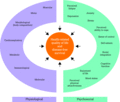Chapter 27: Living with and beyond cancer
Skip chapter table of contents and go to main content


Physical activity for people with cancer
This section will discuss physical activity and how to help support people with cancer to be physically active both during and after treatment. Physical activity is beneficial to everyone including people who have had a cancer diagnosis. Achieving 150 minutes a week of moderate intensity activity can help prevent or manage more than 20 chronic conditions including coronary heart disease, stroke, type 2 diabetes, cancer, obesity, mental health problems and musculo‐skeletal conditions (Department of Health 2012). Cancer diagnosis and treatment has an impact on the body leading to many changes, both physical and psychological. Physical activity is known to decrease as a direct result of cancer diagnosis and treatments (Irwin et al. [132]). As a result of treatment, people frequently become de‐conditioned and lose cardiovascular fitness which can lead to other consequences including fatigue and reduced physical function. Cancer treatment can also have a negative effect on muscle mass and joint mobility which can also affect functional ability and ultimately quality of life. Figure 27.29 illustrates the components of health‐related fitness (Saxton and Daley [247]).

Figure 27.29 Components of health‐related fitness. Source: Saxton and Daley ([247]). Reproduced with permission of Springer Science + Business Media
In recent years there has been an increasing amount of research demonstrating the benefits of physical activity and exercise for people with cancer, such that it is now becoming practice to incorporate it into standard models of care as Figure 27.30 shows (DH [78]). Physical activity also has the advantage that it gives people the opportunity to empower themselves by regaining fitness and consequently improve their quality of life at a time when there is often a feeling of loss of control. However, although the message is that physical activity is an important adjunct to treatment, there are still challenges regarding how to integrate this into practices of care (Davies et al. [66]). One way to assist self‐management is to tailor it to the individual and this can often lead to liaising with and onward referral to specialists in exercise provision.

Figure 27.30 A model of the benefits of physical activity. Source: DH (2011). © Crown copyright. Reproduced under the Open Government Licence v3.0, https://www.nationalarchives.gov.uk/doc/open‐government‐licence/version/3/





